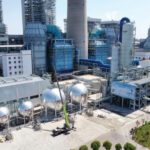The U.S. Environmental Protection Agency (EPA) today proposed what it described as the “first-ever” national standards for “toxic air pollution” from power plants. The new rules—which will replace the court-vacated Clean Air Mercury Rule (CAMR)—will require new and existing coal- and oil-fired plants to install pollution control technologies to curb emissions of mercury, arsenic, chromium, nickel, and acid gases.
The agency proposed the new standards today in response to a court deadline. EPA Administrator Lisa Jackson said that the agency’s action today was “20 years in the making, and is a significant milestone.” A final rule, expected in November, could cost the power sector about $10.9 billion per year according to the EPA’s own analysis of the new rules. Once the rules are in effect, companies would have three years to comply with them.
According to the proposed rules, the EPA is also proposing to revise the new source performance standards (NSPS) for fossil-fueled generating units. This NSPS would revise the standards new coal- and oil-fired power plants must meet for particulate matter (PM), sulfur dioxide (SO2), and nitrogen oxides (NOx).
The EPA has identified two different subcategories of coal-fired generating units, two different subcategories of oil-fired generating units, and a subcategory for units that combust gasified coal or solid oil (integrated gasification and combined cycle units) based on the design of the various types of boilers at different power plants. The proposed air toxics rule includes emission standards and other requirements for each subcategory.
About 1,350 power units are expected to be affected by this action, including some 1,200 existing coal-fired units and 150 oil-fired units at about 525 power plants. The NSPS will affect boilers that burn fuels including coal, oil, or natural gas to produce steam for heat or electricity.
For all existing and new coal-fired generating units, the proposed standards would establish numerical emission limits for mercury, PM (a surrogate for toxic non-mercury metals), and HCl (a surrogate for toxic acid gases). The EPA says that a “range of widely available, technical and economically feasible practices, technologies, and compliance strategies are available to power plants to meet the emission limits,” and that plants could install wet and dry scrubbers, dry sorbent injection systems, activated carbon injection systems, and baghouses.
Power plants were the focus of this rule, the agency said, because they are “the largest remaining source of several toxic air pollutants—responsible for half of mercury and more than half of acid gas emissions in the United States.” The EPA also claims that coal-fired plants are responsible for 99% of mercury emissions. “Currently, more than half of all coal-fired power plants already deploy the widely available pollution control technologies that allow them to meet these important standards,” it said. However, it added: “Once final, these standards will ensure the remaining coal-fired plants, roughly 44 percent, take similar steps to decrease dangerous pollutants.”
The new standards are being proposed more than 20 years after 1990 Clean Air Act Amendments mandated that the EPA require control of toxic air pollutants, including mercury. Since then, the EPA has taken action to reduce mercury emissions from many sources; however, there is still no national standard for mercury emissions from power plants.
Today’s announcement comes 11 years after the EPA announced it would set such limits for power plants. It follows a February 2008 court decision that struck down the Bush administration’s CAMR. In October 2009, the EPA entered into a consent decree that required a proposal to be signed by March 16, 2011, and a final rule to be completed by November 2011.
A public comment period on the new rules will last 60 days after appearing in the Federal Register.
Sources: POWERnews, EPA








